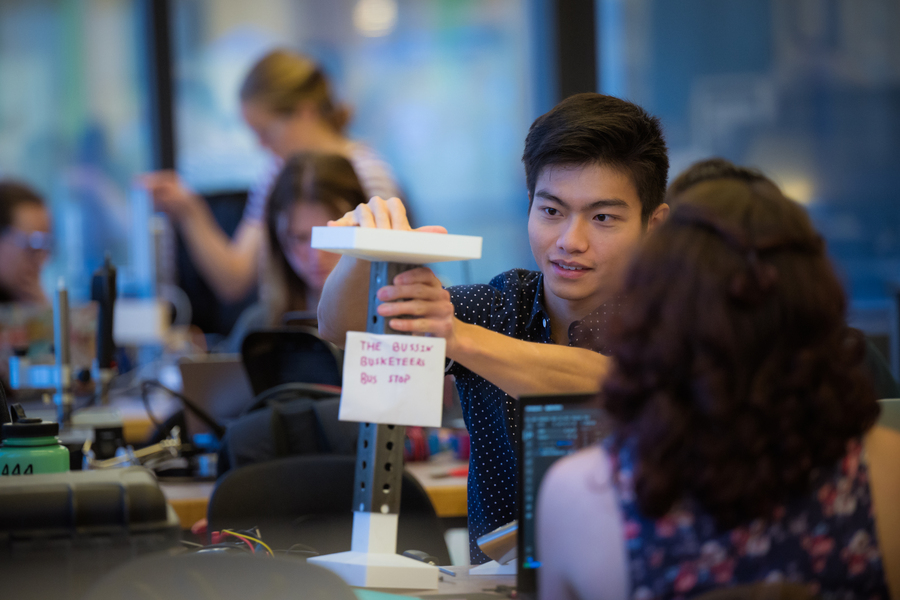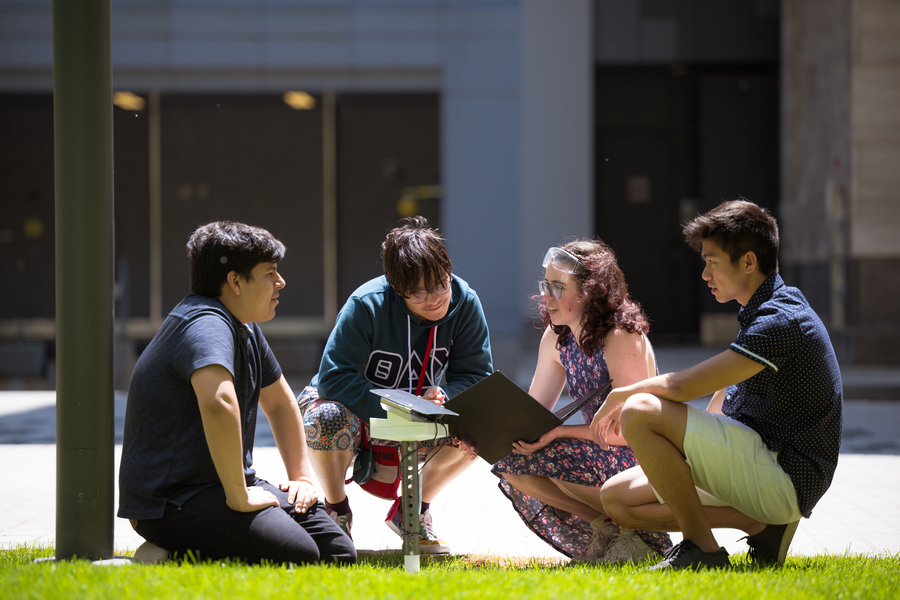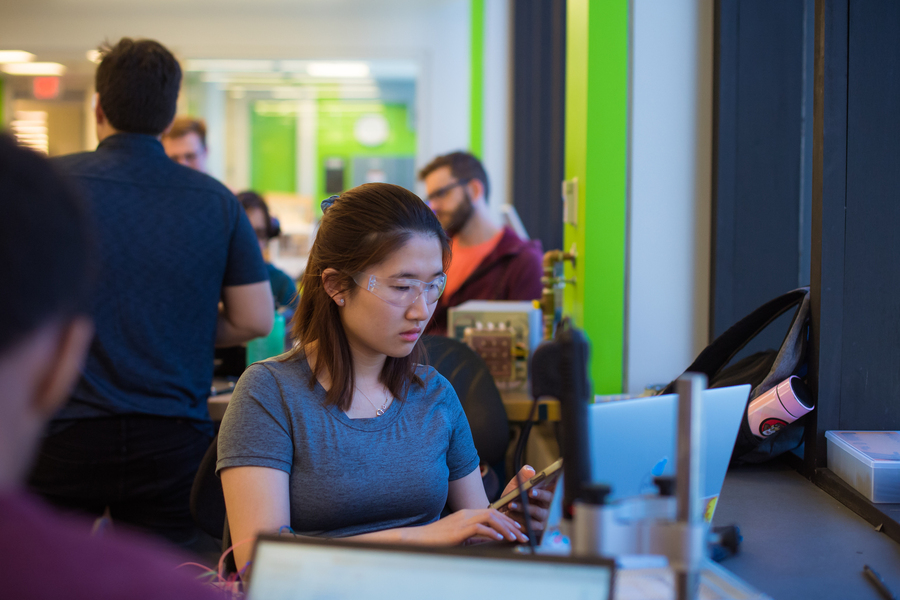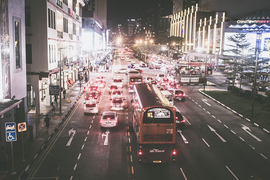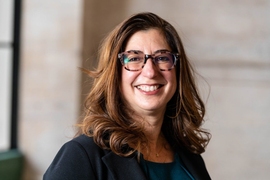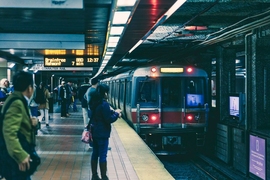Think back to the last time you had to wait for a bus. How miserable were you? If you were in Boston, your experience might have included punishing wind and icy sleet — or, more recently, a punch of pollen straight to the sinuses. But in Florida's Miami-Dade County, where the effects of climate change are both drastic and intensifying, commuters have to contend with an entirely different set of challenges: blistering temperatures and scorching humidity, making long stints waiting in the sun nearly unbearable.
One of Miami’s most urgent transportation needs is shared by car-clogged Boston: coaxing citizens to use the municipal bus network, rather than the emissions-heavy individual vehicles currently contributing to climate change. But buses can be a tough sell in a sunny city where humidity hovers between 60 and 80 percent year-round.
Enter MIT’s Department of Electrical Engineering and Computer Science (EECS) and the MIT Priscilla King Gray (PKG) Public Service Center. The result of close collaboration between the two organizations, class 6.900 (Engineering For Impact) challenges EECS students to apply their engineering savvy to real-world problems beyond the MIT campus.
This spring semester, the real-world problem was heat.
Miami-Dade County Department of Transportation and Public Works Chief Innovation Officer Carlos Cruz-Casas explains: “We often talk about the city we want to live in, about how the proper mix of public transportation, on-demand transit, and other mobility solutions, such as e-bikes and e-scooters, could help our community live a car-light life. However, none of this will be achievable if the riders are not comfortable when doing so.”
“When people think of South Florida and climate change, they often think of sea level rise,” says Juan Felipe Visser, deputy director of equity and engagement within the Office of the Mayor in Miami-Dade. “But heat really is the silent killer. So the focus of this class, on heat at bus stops, is very apt.” With little tree cover to give relief at some of the hottest stops, Miami-Dade commuters cluster in tiny patches of shade behind bus stops, sometimes giving up when the heat becomes unbearable.
A more conventional electrical engineering course might use temperature monitoring as an abstract example, building sample monitors in isolation and grading them as a merely academic exercise. But Professor Joel Volman, EECS faculty head of electrical engineering, and Joe Steinmeyer, senior lecturer in EECS, had something more impactful in mind.
“Miami-Dade has a large population of people who are living in poverty, undocumented, or who are otherwise marginalized,” says Voldman. “Waiting, sometimes for a very long time, in scorching heat for the bus is just one aspect of how a city population can be underserved, but by measuring patterns in how many people are waiting for a bus, how long they wait, and in what conditions, we can begin to see where services are not keeping up with demand.”
Only after that gap is quantified can the work of city and transportation planners begin, Cruz-Casas explains: “We needed to quantify the time riders are exposed to extreme heat and prioritize improvements, including on-time performance improvements, increasing service frequency, or looking to enhance the tree canopy near the bus stop.”
Quantifying that time — and the subjective experience of the wait — proved tricky, however. With over 7,500 bus stops along 101 bus routes, Miami-Dade’s transportation network presents a considerable data-collection challenge. A network of physical temperature monitors could be useful, but only if it were carefully calibrated to meet the budgetary, environmental, privacy, and implementation requirements of the city. But how do you work with city officials — not to mention all of bus-riding Miami — from over 2,000 miles away?
This is where the PKG Center comes in. “We are a hub and a connector and facilitator of best practices,” explains Jill Bassett, associate dean and director of the center, who worked with Voldman and Steinmeyer to find a municipal partner organization for the course. “We bring knowledge of current pedagogy around community-engaged learning, which includes: help with framing a partnership that centers community-identified concerns and is mutually beneficial; identifying and learning from a community partner; talking through ways to build in opportunities for student learners to reflect on power dynamics, reciprocity, systems thinking, long-term planning, continuity, ethics, all the types of things that come up with this kind of shared project.”
Through a series of brainstorming conversations, Bassett helped Voldman and Steinmeyer structure a well-defined project plan, as Cruz-Casas weighed in on the county’s needed technical specifications (including affordability, privacy protection, and implementability).
"This course brings together a lot of subject area experts,” says Voldman. “We brought in guest lecturers, including Abby Berenson from the Sloan Leadership Center, to talk about working in teams; engineers from BOSE to talk about product design, certification, and environmental resistance; the co-founder and head of engineering from MIT spinout Butlr to talk about their low-power occupancy sensor; Tony Hu from MIT IDM [Integrated Design and Management] to talk about industrial design; and Katrina LaCurts from EECS to talk about communications and networking.”
With the support of two generous donations and a gift of software from Altium, 6.900 developed into a hands-on exercise in hardware/software product development with a tangible goal in sight: build a better bus monitor.
The challenges involved in this undertaking became apparent as soon as the 6.900 students began designing their monitors. “The most challenging requirement to meet was that the monitor be able to count how many people were waiting — and for how long they’d been standing there — while still maintaining privacy,” says Fabian Velazquez ’23 a recent EECS graduate. The task was complicated by commuters’ natural tendency to stand where the shade goes — whether beneath a tree or awning or snaking against a nearby wall in a line — rather than directly next to the bus sign or inside the bus shelter. “Accurately measuring people count with a camera — the most straightforward choice — is already quite difficult since you have to incorporate machine learning to identify which objects in frame are people. Maintaining privacy added an extra layer of constraint … since there is no guarantee the collected data wouldn’t be vulnerable.”
As the groups weighed various privacy-preserving options, including lidar, radar, and thermal imaging, the class realized that Wi-Fi “sniffers,” which count the number of Wi-Fi enabled signals in the immediate area, were their best option to count waiting passengers. “We were all excited and ready for this amazing, answer-to-all-our-problems radar sensor to count people,” says Velasquez. “That component was extremely complex, however, and the complexity would have ultimately made my team use a lot of time and resources to integrate with our system. We also had a short time-to-market for this system we developed. We made the trade-off of complexity for robustness.”
The weather also posed its own set of challenges. “Environmental conditions were big factors on the structure and design of our devices,” says Yong Yan (Crystal) Liang, a rising junior majoring in EECS. “We incorporated humidity and temperature sensors into our data to show the weather at individual stops. Additionally, we also considered how our enclosure may be affected by extreme heat or potential hurricanes.”
The heat variable proved problematic in multiple ways. “People detection was especially difficult, for in the Miami heat, thermal cameras may not be able to distinguish human body temperature from the surrounding air temperature, and the glare of the sun off of other surfaces in the area makes most forms of imaging very buggy,” says Katherine Mohr ’23. “My team had considered using mmWave sensors to get around these constraints, but we found the processing to be too difficult, and (like the rest of the class), we decided to only move forward with Wi-Fi/BLE [Bluetooth Low Energy] sniffers.”
The most valuable component of the new class may well have been the students’ exposure to real-world hardware/software engineering product development, where limitations on time and budget always exist, and where client requests must be carefully considered. “Having an actual client to work with forced us to learn how to turn their wants into more specific technical specifications,” says Mohr. “We chose deliverables each week to complete by Friday, prioritizing tasks which would get us to a minimum viable product, as well as tasks that would require extra manufacturing time, like designing the printed-circuit board and enclosure.”
Video: MIT Open Learning
Crystal Liang counted her conversations with city representatives as among her most valuable 6.900 experiences. “We generated a lot of questions and were able to communicate with the community leaders of this project from Miami-Dade, who made time to answer all of them and gave us ideas from the goals they were trying to achieve,” she reports. “This project gave me a new perspective on problem-solving because it taught me to see things from the community members’ point of view.” Some of those community leaders, including Marta Viciedo, co-founder of Transit Alliance Miami, joined the class’s final session on May 16 to review the students’ proposed solutions.
The students’ thoughtful approach paid off when it was time to present the heat monitors to the class’s client. In a group conference call with Miami-Dade officials toward the end of the semester, the student teams shared their findings and the prototypes they’d created, along with videos of the devices at work. Juan Felipe Visser was among those in attendance. “This is a lot of work,” he told the students following their presentation. “So first of all, thank you for doing that, and for presenting to us. I love the concept. I took the bus this morning, as I do every morning, and was battered by the sun and the heat. So I personally appreciated the focus.”
Cruz-Casas agreed: “I am pleasantly surprised by the diverse approach the students are taking. We presented a challenge, and they have responded to it and managed to think beyond the problem at hand. I’m very optimistic about how the outcomes of this project will have a long-lasting impact for our community. At a minimum, I’m thinking that the more awareness we raise about this topic, the more opportunities we have to have the brightest minds seeking for a solution.”
The creators of 6.900 agree, and hope that their class helps more MIT engineers to broaden their perspective on the meaning and application of their work.
“We are really excited about students applying their skills within a real-world, complex environment that will impact real people,” says Bassett. “We are excited that they are learning that it’s not just the design of technology that matters, but that climate; environment and built environment; and issues around socioeconomics, race, and equity, all come into play. There are layers and layers to the creation and deployment of technology in a demographically diverse multilingual community that is at the epicenter of climate change.”
